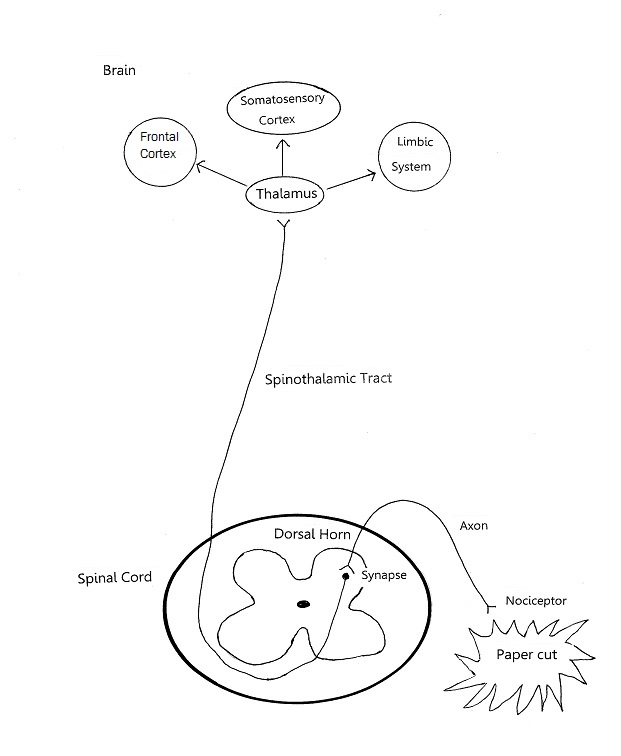Over the next few entries, I will break down and explain the different types of pain and pain responses; why and how we hurt, what happens when things go wrong and healing does not go according to “schedule”.
Nociceptive (normal) pain
This is pain in response to a cut, a fracture, toe stubbing, the accidental touching of a hot element on a stove. Post-operative pain is another form of nociceptive pain. The intensity and quality of this pain response are appropriate to the applied stimulus.
Let’s use a paper cut as an example:
1) This tissue damage is registered by nociceptors (pain receptors) in your skin which send a signal up to the spinal cord in your neck along an axon (this is a nerve fibre which connects a pain receptor to the spinal cord). Many axons form a peripheral nerve.
2) Within the dorsal horn of the spinal cord, this signal is transmitted via a series of synapses, and then passed up into the brain. Chemical messengers (neurotransmitters) pass this signal across the synapses.
3) On reaching the thalamus in the brain, this signal is streamed to different parts of the brain such as:
a. Somatosensory cortex, giving you the sensation of pain
b. Frontal cortex, making you think, “Ow! What did I do?”
c. Limbic system, resulting in annoyance or irritation on getting a paper cut.
Hopefully, the diagram below will help to simplify things for those of us who learn better this way:
Nociceptive (normal) pain
This is pain in response to a cut, a fracture, toe stubbing, the accidental touching of a hot element on a stove. Post-operative pain is another form of nociceptive pain. The intensity and quality of this pain response are appropriate to the applied stimulus.
Let’s use a paper cut as an example:
1) This tissue damage is registered by nociceptors (pain receptors) in your skin which send a signal up to the spinal cord in your neck along an axon (this is a nerve fibre which connects a pain receptor to the spinal cord). Many axons form a peripheral nerve.
2) Within the dorsal horn of the spinal cord, this signal is transmitted via a series of synapses, and then passed up into the brain. Chemical messengers (neurotransmitters) pass this signal across the synapses.
3) On reaching the thalamus in the brain, this signal is streamed to different parts of the brain such as:
a. Somatosensory cortex, giving you the sensation of pain
b. Frontal cortex, making you think, “Ow! What did I do?”
c. Limbic system, resulting in annoyance or irritation on getting a paper cut.
Hopefully, the diagram below will help to simplify things for those of us who learn better this way:


 RSS Feed
RSS Feed